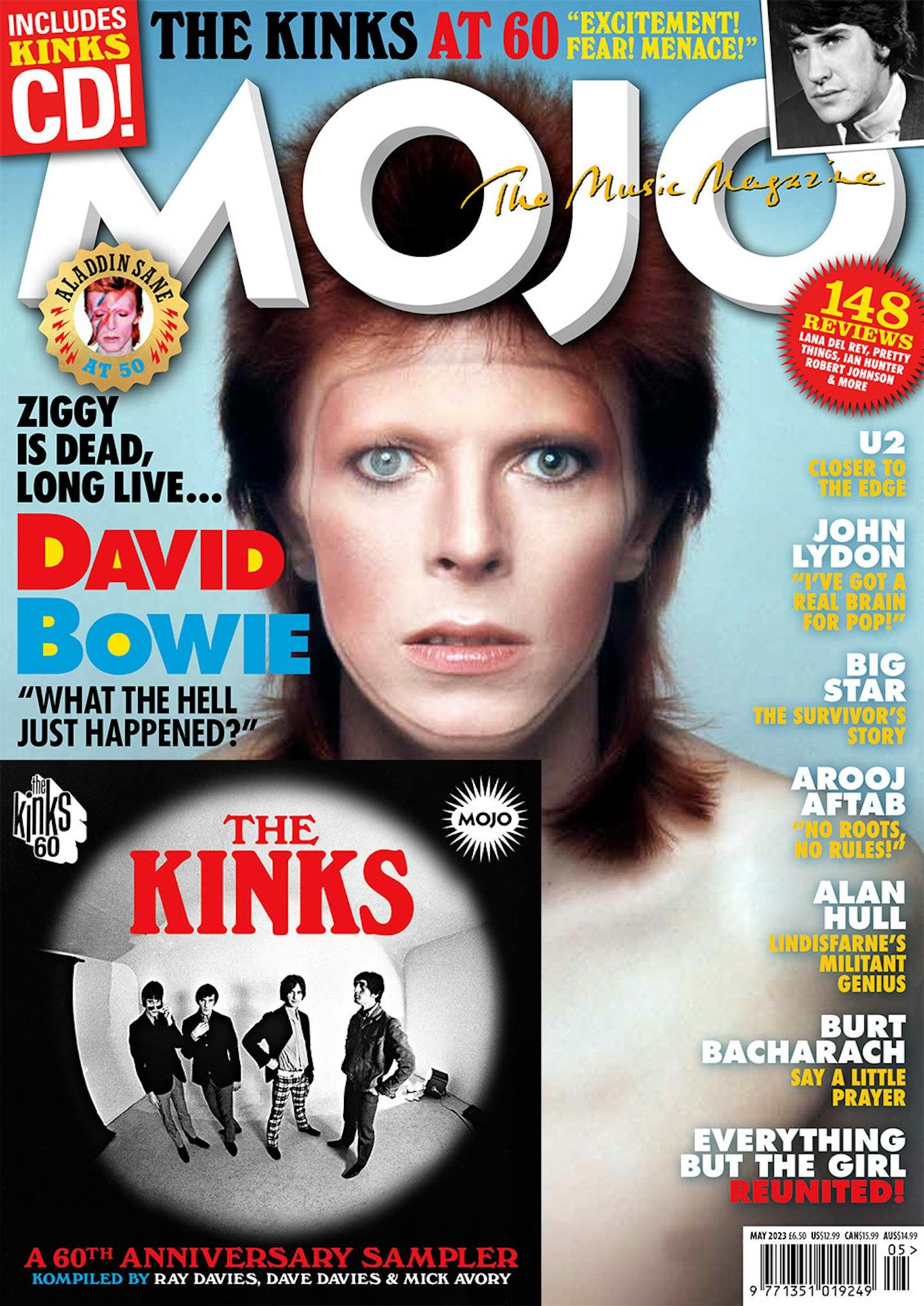In 1973, David Bowie’s glam rock alter ego Ziggy Stardust had finally catapulted him to the fame he had craved for so long. However, success and a spiralling drug habit were beginning to reveal the madness behind Bowie’s beguiling new mask. In this extract from MOJO’s exclusive David Bowie cover story, band members and friends recall Bowie’s decision to kill off his famous creation and the night of the final Spiders From Mars show…
READ THE FEATURE IN FULL!
Aladdin Sane was released on April 20, 1973, and went straight to UK Number 1 on its 100,000 pre-sales alone – an advance orders tally not seen since Abbey Road. But, from manager Tony Defries’s perspective, it was in this first half of 1973 that Bowie first began to feel uneasy with stardom.
“Basically, I think success wasn’t the ideal situation for David,” he says now. “When Aladdin Sane was selling enormous quantities and crowds were shutting down railway stations, just to get a glance of him, I think that’s when it all began to sink in, that he was no longer an ordinary person. The Ziggy effect was taking hold and he couldn’t cope with it, really.”
Geoff MacCormack, who had joined the Ziggy tour as backing vocalist/percussionist and become Bowie’s closest friend and travelling companion, disagrees.
“I think he was ready for fame,” he says. “I don’t think it fazed him that much. He very cleverly kind of ducked away from it. He kept himself at arm’s length, and he slowed his pace down. Y’know, not travelling by plane and travelling very sedately by boat and whatever.”
When the nine-date Japanese leg of the tour finished in Tokyo at the end of April, the increasingly aviophobic Bowie elected to travel back to Europe with MacCormack, first via ship (the Felix Dzerzhinsky, sailing from Yokohama to Nadhodka) and then train: the Trans-Siberian Express to Moscow, and onwards to Paris. “I think that downtime gave him time to draw breath and take his mind off what was happening,” MacCormack says.
En route, on the Trans-Siberian Express, Bowie picked up his acoustic guitar and gave an impromptu performance in his and MacCormack’s twin cabin for a handful of their fellow travellers. “Maybe seven people, but that’s a lot in this small room,” MacCormack remembers. “There’s David with his guitar doing the smallest concert in the world.”
We were like, What the hell just happened?
Woody Woodmansey
Back in the UK, and in secret, Defries and Bowie began to formulate a retirement plan for Ziggy. The former now says that the inspiration for the scheme came from Frank Sinatra’s 1971 announcement of his retirement. By 1973, anticipation was building for his dramatic comeback with Ol’ Blue Eyes Is Back.
“David was a big Sinatra fan,” says Defries. “Making the comeback is the key thing. We tried and failed to get promoters in America to book David into large arenas as a headliner. So, that was a real reason for retiring Ziggy, to be honest with you… nothing to do with music or style or anything else.”
READ: DAVID BOWIE'S 50 GREATEST SONGS!
“A lot of it was based around finance,” MacCormack says. “How much the management could get out of the record companies to pay for even bigger and better plans. But the whole thing about managing David in David’s situation… he was kind of a moving target. This was the plan this day, then this was the plan the other day.”
MacCormack was one of the few people close to Bowie who knew that he planned to announce Ziggy and The Spiders’ retirement at the last Hammersmith Odeon show in London on July 3. “Because I hung with David, I would have been in earshot of meetings. I wasn’t a paid musician as such. So, it wasn’t, ‘Oh where’s my next gig?’ It was more, ‘Well, this is fun, for as long as it lasts.’”
“Mick [Ronson] knew that we were doing our last Ziggy,” Defries says, “whereas Woody and Trevor didn’t. I didn’t want too many people to know. Where’s the publicity value if you tell too many people? So, tell as few people as possible.
“But,” he adds, “I said, ‘If we’re gonna retire, then we’ve got to retire in style and have a huge party and invite everybody.’ It was a celebration.”
The ostentatious aftershow bash thrown at the Café Royal in Piccadilly on the night of the Hammersmith show was a public statement of Bowie’s status and pulling power. Along with the usual rock star suspects – Jagger, Ringo, the McCartneys – there was a Hollywood aura lent to the proceedings by Barbra Streisand, Tony Curtis, Janet Leigh, Britt Ekland and Ryan O’Neal.
“Someone managed to put Barbra Streisand and Elliott Gould, her ex-husband, at the same table,” Defries recalls. “We had to shuffle them around to avoid an embarrassing incident.”
Aladdin Sane vocalist Linda Lewis was in attendance and gobsmacked to spot Angie Bowie and Bianca Jagger kissing. “Everyone was being so outrageous, and I was walking around a little bit prudish, actually,” she laughs. “Back then, the way I saw it through my sort of naïve eyes, it was like, ‘Wow, oh my God… two ladies together.’”
Not everyone was digging the wild and starry party vibes. Woody Woodmansey and Trevor Bolder had been left traumatised by Bowie’s announcement. “We were like… ‘What the hell just happened?’” says Woodmansey. “And we didn’t get an answer...”
“David was hardcore…” Read MOJO’s feature in full to find out the inside story behind the making of Aladdin Sane and Pin Ups, how stardom cracked Bowie’s psyche and the new musical future he would find post-Ziggy.
ORDER THE LATEST ISSUE OF MOJO HERE!

